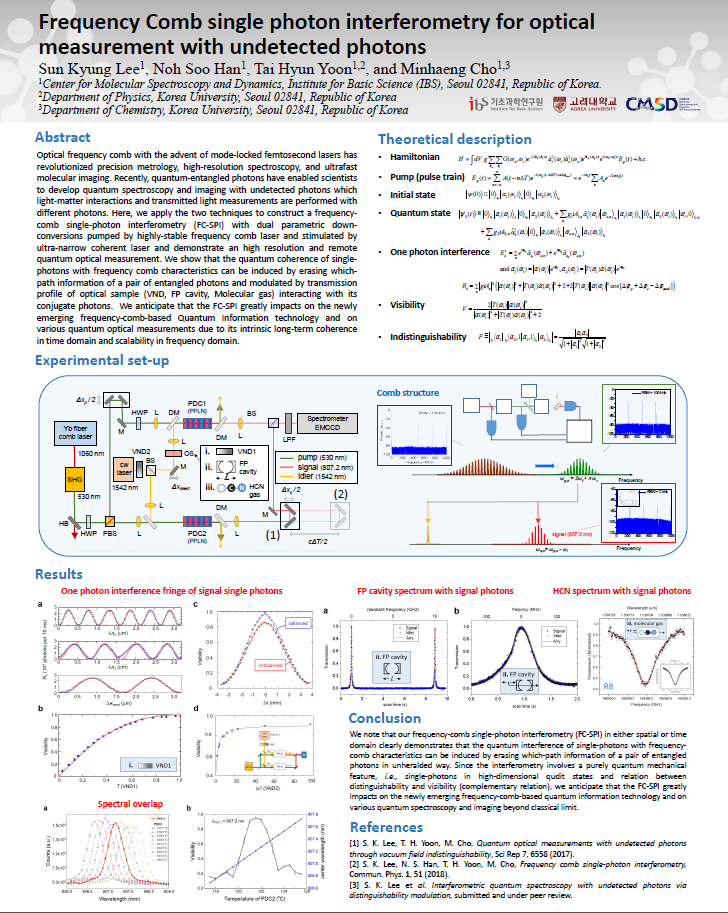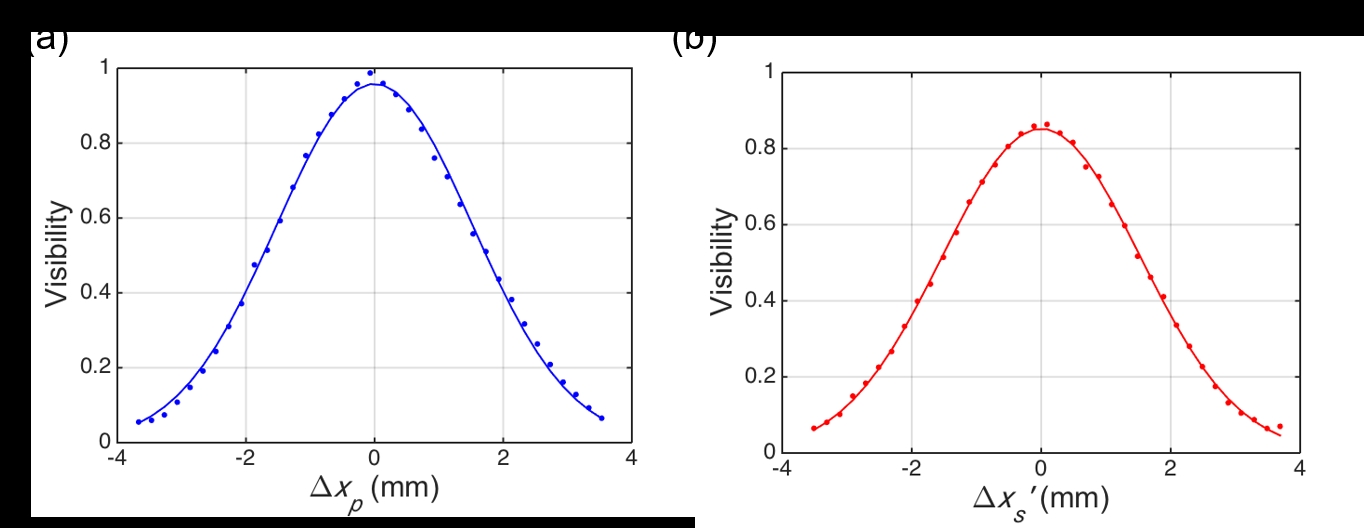mainmenu
Frequency Comb single photon interferometry for optical measurement with undetected photons
QIM 2019

1. Introduction
Recently, two promising advancements in quantum optics are new developments in quantum frequency comb technique and quantum measurement with entangled photons. Optical frequency comb has completely revolutionized high precision measurements in spectroscopy and metrology and recent notable works employing quantum frequency comb provides a fascinating platform for the quantum technology based on high dimensional quantum due to the intrinsic coherence in time domain and scalability in frequency domain. On the other hand, the entangled photons have been widely used for quantum information technology such as linear quantum computation, quantum communication, quantum cryptography and quantum metrology. In these days, it has been further shown to be of use in quantum spectroscopy and imaging with undetected photons [1-5], which is based on the single photon interferometry constructed by erasing the which way information of conjugate photons generated from two separate down converters. Since the degree of path-indistinguishability for the generated idler photons is modulated by the amplitude and phase change of the idler field due to the light-material, the modulated the interference fringe of the conjugate signal photons reflects the optical property of the material interacting with idler filed. Our frequency-comb single-photon interferometry in either spatial or time domain clearly demonstrates that the quantum interference of single-photons with frequency-comb characteristics can be induced by erasing which-path information of a pair of entangled photons in unheralded way.
2. Results
In this work, we combine the two techniques in one system to demonstrate quantum optical measurements with undetected photons via frequency comb single photon interferometry. Single photon states with comb structure are prepared by means of stimulated parametric down conversion pumped by a frequency comb laser and an ultra-narrow (1 Hz) seeding laser in a small down conversion regime. Coherence of single (signal) photons generated from two different nonlinear crystals results from indistinguishability of their conjugate entangled (idler) photons. One (signal) photon interference pattern shows almost unit visibility and the latter is modulated by the optical property of material interacting with undetected idler photons [6], i.e., absorption measurement (Fig 1). The visibility V (wave nature) of one photon interference of signal photons and the distinguishability of idler photons K (particle nature) should satisfy the complementary relation, i.e., V2+K2=1. Furthermore, the generated multidimensional frequency encoded single photons show exceptionally longer term phase coherence of single photon pulses due to its frequency comb feature (Fig 2). We note that we generated a multi-dimensional frequency encoded quantum state thanks to the long term phase coherence of frequency comb single photons and believe that our work greatly impacts on the newly emerging frequency-comb-based quantum information technology and on various quantum optical measurements beyond classical limit.

Fig. 1. Induced one photon interference (a) Schematics diagram of the experimental setup that the frequency comb single photon interferometry consists of two parametric down converters (PDC) driven by optical frequency comb (OFC) pump beam and sub Hz linewidth continuous wave (CW) seed beam. (b) The visibility of induced one photon interference with respect to the idler beam transmission (T). Dots are experimental data and solid curve is the theoretical function, V=2T|α|2/(2+|α|2+T2|α|2) for |α|2~100. Inset plot is interference fringe versus pump beam path length difference.

Fig. 2. Visibility of one-photon interference with frequency comb encoded single photons. (a) Interference visibilities measured experimentally are plotted with respect to Δxp in Fig. 1(a). The maximum visibility approaches unity, when the two signal beams overlap in space and frequency and when the path-length differences of both the pump and the signal beams are zero. (b) The visibilities are plotted with respect to the Δxs’s of the signal beam in the lower path. Here, the lower signal beam path is deliberately made longer than the upper signal beam path by 1.2 m, which corresponds to c/frep, Δxs’ = Δxs - c/frep, where 1/ frep = 4 ns, c is the speed of light and frep is a repetition rate of OFC. In this figure, the dots and the solid represent the experimental data and the fitted Gaussian function, respectively.
3. References
[1] X. Zou, L. J. Wang, L. Mandel, “Induced coherence and indistinguishability in optical interference,” Phys Rev Lett 67, 318 (1991).
[2] Z. Ou , L. Wang, X. Zou, L. Mandel, “Coherence in two-photon down-conversion induced by a laser,” Phys Rev A 41, 1597 (1990).
[3] G. B. Lemos, V. Borish, G. D. Cole, S. Ramelow, R. Lapkiewicz, A. Zeilinger, Quantum imaging with undetected photons,” Nature 512, 409 (2014).
[4] D. A. Kalashnikov, A. V. Paterova, S. P. Kulik, L. A. Krivitsky, “Infrared spectroscopy with visible light,” Nat Photon 10, 98 (2016).
[5] S. K. Lee, T. H. Yoon, M. Cho, “Quantum optical measurements with undetected photons through vacuum field indistinguishability,” Sci Rep 7, 6558 (2017).
[6] S. K. Lee, N. S. Han, T. H. Yoon, M. Cho, Frequency comb single-photon interferometry. Commun. Phys. 1, 51 (2018).


